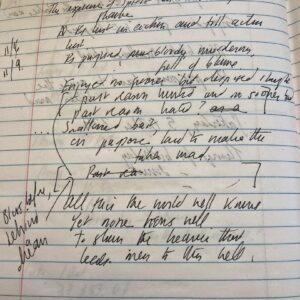It started out just as a random weekday text message to a friend, a propos of nothing in particular. I was supposed to be working, but it was on my mind and I couldn’t shake it off.
“Hey!” I punched into my iphone to my old friend Teddy. “Given what we have learned since growing older about issues of race and justice, how well do you feel that Dilsey holds up?”
After a minute, he wrote write back and said, “I wasn’t wearing my glasses and read that as “Disney.” But then he turned to address my question seriously. There’s nothing like a friend to whom you can address a late-night dorm room question in the middle of a Tuesday—especially when you are over 50.
Dilsey, of course, is the faithful Black housekeeper at the center of William Faulkner’s The Sound and the Fury. In a house where the parents are adrift in sadness and the three sons (don’t ask about the daughter) are alternately simple, monstrous, and insane, Dilsey is the not only the moral center of the story but its very stability: the Compsons’ house is full of clocks that are all displaying the wrong time; only Dilsey knows what the real time is. On Easter morning, she is the only member of the household who admits the significance of the day.
But how would Dilsey herself write her story?Who cares? is the standard response from the more “traditional” aspirational school of literary theory. This view holds that a good artist will have the imaginative capacity to write about someone utterly unlike himself (see what I did there?), and that there’s real danger in insisting that the lives of members of narrow demographics be written about by members of those same groups—what we might call the #ownvoices fallacy. People should write about whatever they want.
I don’t really disagree with that perspective—just off the top of my head, I think (Black) writer Marlon James did a bang-up job representing a dissolute middle-aged (White) CIA officer in his vast, compelling novel about Jamaican politics and poverty, A Brief History of Seven Killings.
Similarly, I think (White) Michael Chabon’s Black protagonist Archy Stallings in his sprawling social novel about progressive Oakland, Telegraph Avenue, has as much independence or agency as his far more annoying White record store co-owner Nat Jaffe. (They come as a matched set, like pairs of interracial squad-car partners in cop shows of the 70s and 80s.)
At the same time, I do have my own suspicions about the voices that get neglected amid the shimmery fairy-dust of Platonic “standards.”
Which brings me back to Dilsey. Within Faulkner’s Yoknapatawpha universe, making Dilsey the spiritual center, the concrete embodiment of Christian faith, was doubtlessly intended to be the exact opposite of a racist gesture. But is putting her on a pedestal actually a form of condescension, only a cut above the “magic Negro” characters in movies who are the unwitting midwives of White enlightenment?
Meanwhile Teddy, back on the text thread: “…I cringe at some of the passages, mainly when she comes across as trying to hold the family together….” For who dragooned Dilsey into being the last support of the sorrowing Compsons? Shouldn’t her life be her own?
But of course, it was not. Still, she read the clocks, and whatever paternalism is encoded in her character, the reproach against it is, also. “I’ve seed de first en de last.…I seed de beginnin, en now I sees de endin…” she says, and the saying is perhaps more capacious than the hand that made her say it. This essentially, is the understanding that writer Michael Gorra comes to in his recent The Saddest Words: William Faulkner’s Civil War. His view is cited by Drew Gilpin Faust in her review “What to Do About William Faulkner,” in the September issue of The Atlantic: “Gorra makes his claim for Faulkner the writer by reproving Faulkner the man.” However much a racist Faulkner was, his own character Quentin Compson ends up calling him out—a view that’s echoed in John Jeremiah Sullivan’s incredibly moving foreword to the most recent Modern Library edition of Absalom Absalom—the later volume of the Compsons’ history.
Teddy and I both grew up in the Mississippi Delta; both of us have spent decades trying to pull apart the insidious infrastructure of everything we’ve been taught about the South and race, and how it continues to manifest itself, even now—a task that it seems like we are going to have to do for a fair amount of time to come.
In that task, it has been good for me to have my own perspective de-centered. I live in a modest, majority-Black suburb of Washington, DC. A couple of years ago, I was suddenly witness to an encounter, in my own living room, of a White young police officer interrogating a Black neighbor of mine scornfully—a police officer whom I’d called on her behalf and at her request. All at once, everything I had thought about The Way The World Works fell away, and I found myself unsettled, on shaky ground. I understood a perspective I had conveniently been able to evade. I had been forced to live inside my neighbor’s reality.
But that is what the best literature does, doesn’t it? To put us on shaky ground.
Or pull us up, painfully, out of the shadows to which we’ve become accustomed.
Caroline Langston was a regular contributor to Image’s Good Letters blog, and is writing a memoir about the U.S. cultural divide. She has contributed to Sojourners’ God’s Politics blog, and aired several commentaries on NPR’s All Things Considered, in addition to writing book reviews for Image, Books and Culture, and other outlets. She is a native of Yazoo City, Mississippi, and a convert to the Eastern Orthodox Church. She lives outside Washington, D.C., with her husband and two children.





